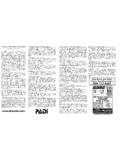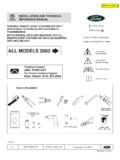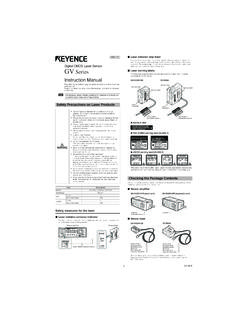Transcription of HIGHLIGHTS OF PRESCRIBING INFORMATION - Aldurazyme
1 _____ HIGHLIGHTS OF PRESCRIBING INFORMATION These HIGHLIGHTS do not include all the INFORMATION needed to use Aldurazyme safely and effectively. See full PRESCRIBING INFORMATION for Aldurazyme . Aldurazyme (LARONIDASE) Solution for intravenous infusion only Initial Approval: 2003 ----------------------------INDICATIONS AND USAGE---------------------------- Aldurazyme is a hydrolytic lysosomal glycosaminoglycan (GAG)-specific enzyme indicated for patients with Hurler and Hurler-Scheie forms of Mucopolysaccharidosis I (MPS I) and for patients with the Scheie form who have moderate to severe symptoms. The risks and benefits of treating mildly affected patients with the Scheie form have not been established.
2 Aldurazyme has been shown to improve pulmonary function and walking capacity. Aldurazyme has not been evaluated for effects on the central nervous system manifestations of the disorder (1). ------------------------DOSAGE AND ADMINISTRATION----------------------- mg/kg of body weight administered once weekly as an intravenous (IV) infusion (2). ----------------------DOSAGE FORMS AND STRENGTHS---------------------- Solution: mg/5 mL vial (3). -----------------------------CONTRAINDIC ATIONS-------------------------------- None (4) ------------------------WARNINGS AND PRECAUTIONS------------------------ Anaphylaxis and Allergic Reactions: Life-threatening anaphylactic reactions have been observed in some patients during Aldurazyme infusion and up to 3 hours after infusion.
3 Appropriate medical support and monitoring measures should be readily available when Aldurazyme is administered. If anaphylactic or other severe allergic reactions occur, immediately discontinue the infusion and initiate appropriate treatment, which may include ventilatory support, treatment with inhaled beta-adrenergic agonists, epinephrine, and IV corticosteroids ( ). Risk of Acute Respiratory Complications: Patients with acute febrile or respiratory illness at the time of Aldurazyme infusion may be at greater risk for infusion reactions. Consider delaying Aldurazyme infusion. Sleep apnea is common in MPS I patients. Evaluation of airway patency should be considered prior to initiation of treatment with Aldurazyme .
4 Appropriate respiratory support should be available during infusion ( ). Risk of Acute Cardiorespiratory Failure: Caution should be exercised when administering Aldurazyme to patients susceptible to fluid overload. Consider a decreased total infusion volume and infusion rate when administering Aldurazyme to these patients. Appropriate medical monitoring and support measures should be available during infusion ( , ). Infusion Reactions: Pretreatment is recommended prior to the infusion to reduce the risk of infusion reactions and may include antihistamines, antipyretics, or both. If infusion reactions occur, decreasing the infusion rate, temporarily stopping the infusion, or administering additional antipyretics and/or antihistamines may ameliorate the symptoms ( ).
5 ------------------------------ADVERSE REACTIONS------------------------------- - The most commonly reported infusion reactions occurring in at least 10% of patients 6 months of age and older were pyrexia, chills, blood pressure increased, tachycardia, and oxygen saturation decreased (6). The most frequently occurring adverse reactions occurring in at least 10% of patients 6 years and older are rash, upper respiratory tract infection, injection site reaction, hyperreflexia, paresthesia, flushing, and poor venous access. To report SUSPECTED ADVERSE REACTIONS, contact: Genzyme at 1-800-745-4447, or FDA at 1-800-FDA-1088 or go to ------------------------USE IN SPECIFIC POPULATIONS----------------------- A registry for pregnant women is available.
6 Pregnant women with MPS I should be encouraged to enroll in the MPS I Registry. For more INFORMATION , visit or call (800) 745-4447 ( ). See 17 for PATIENT COUNSELING INFORMATION . Revised: 04/2013_____ FULL PRESCRIBING INFORMATION : CONTENTS* WARNING: RISK OF ANAPHYLAXIS 1 INDICATIONS AND USAGE 2 DOSAGE AND ADMINISTRATION Recommended Dose Instructions for Use 3 DOSAGE FORMS AND STRENGTHS 4 CONTRAINDICATIONS 5 WARNINGS AND PRECAUTIONS Anaphylaxis and Allergic Reactions Acute Respiratory Complications Associated with Administration Risk of Acute Cardiorespiratory Failure Infusion Reactions 6 ADVERSE REACTIONS Clinical Trials Experience Immunogenicity Postmarketing Experience 8 USE IN SPECIFIC POPULATIONS Pregnancy Nursing Mothers Pediatric Use Geriatric Use 10 OVERDOSAGE 11 DESCRIPTION 12 CLINICAL PHARMACOLOGY Mechanism of Action
7 Pharmacodynamics Pharmacokinetics 13 NONCLINICAL TOXICOLOGY CARCINOGENESIS, MUTAGENESIS, IMPAIRMENT OF FERTILITY 14 CLINICAL STUDIES Clinical Studies in Patients 6 Years and Older Clinical Studies in Patients 6 Years and Younger 16 HOW SUPPLIED/STORAGE AND HANDLING 17 PATIENT COUNSELING INFORMATION *Sections or subsections omitted from the Full PRESCRIBING INFORMATION are not listed. WARNING: RISK OF ANAPHYLAXIS. See full PRESCRIBING INFORMATION for complete boxed warning. Life-threatening anaphylactic reactions have been observed in some patients during Aldurazyme infusions. Therefore, appropriate medical support should be readily available when Aldurazyme is administered.
8 Patients with compromised respiratory function or acute respiratory disease may be at risk of serious acute exacerbation of their respiratory compromise due to infusion reactions, and require additional monitoring. 2 FULL PRESCRIBING INFORMATION 1 INDICATIONS AND USAGE Aldurazyme (laronidase) is indicated for patients with Hurler and Hurler-Scheie forms of Mucopolysaccharidosis I (MPS I) and for patients with the Scheie form who have moderate to severe symptoms. The risks and benefits of treating mildly affected patients with the Scheie form have not been established. Aldurazyme has been shown to improve pulmonary function and walking capacity. Aldurazyme has not been evaluated for effects on the central nervous system manifestations of the disorder.
9 2 DOSAGE AND ADMINISTRATION Recommended Dose The recommended dosage regimen of Aldurazyme is mg/kg of body weight administered once weekly as an intravenous (IV) infusion. Pretreatment is recommended 60 minutes prior to the start of the infusion and may include antihistamines, antipyretics, or both [see Warnings and Precautions (5)]. Each vial of Aldurazyme provides milligrams (mg) of laronidase in milliliters (mL) of solution and is intended for single use only. Do not use the vial more than one time. The concentrated solution for infusion must be diluted with Sodium Chloride Injection, USP, to a final volume of 100 mL or 250 mL, using aseptic techniques. The final volume of the infusion is determined by the patient s body weight.
10 Patients with a body weight of 20 kg or less should receive a total volume of 100 mL. Patients with a body weight greater than 20 kg should receive a total volume of 250 mL [see Dosage and Administration ( )]. For patients with underlying cardiac or respiratory compromise and weighing up to 30 kg, physicians may consider diluting Aldurazyme in a volume of 100 mL and administering at a decreased infusion rate [see Dosage and Administration ( ), Warnings and Precautions ( ) and Adverse Reactions ( )]. Instructions for Use Prepare and use Aldurazyme according to the following steps. Use aseptic techniques. Prepare Aldurazyme using low-protein-binding containers and administer with a low-protein-binding infusion set equipped with an in-line, low-protein-binding micrometer ( m) filter.




